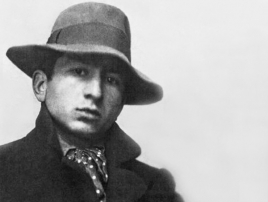Yeghishe Charents
Friday, January 3, 2025
Yeghishe Charents (March 13, 1897 – November 27, 1937) was an Armenian poet, writer and public activist. Charents' literary subject matter ranged from his experiences in the First World War, socialist revolution, and frequently Armenia and Armenians.
He is recognized as "the main poet of the 20th century" in Armenia.
An early supporter of communism, Charents joined the Bolshevik party, but as the Stalinist terror began in the 1930s, he gradually grew disillusioned with Stalinism and died during the 1930s purges.
Early life
Yeghishe Charents was born Yeghishe Abgari Soghomonyan in Kars (Eastern Armenia, then a part of the Russian Empire) in 1897 to a family involved in the rug trade. His family hailed from the Armenian community of Maku, Persian Armenia. He first attended an Armenian elementary school, but later transferred to a Russian technical secondary school in Kars from 1908 to 1912. He spent much of his time in reading. In 1912, he had his first poem published in the Armenian periodical Patani (Tiflis). In 1915, amid the upheavals of the First World War and the Armenian Genocide in the Ottoman Empire, he volunteered to fight in a detachment on the Caucasian Front.
Political and literary development
Sent to Van in 1915, Charents was witness to the destruction that the Turkish garrison had laid upon the Armenian population, leaving indelible memories that would later be read in his poems. He left the front one year later, attending school at the Shanyavski People's University in Moscow. The horrors of the war and genocide had scarred Charents and he became a fervent supporter of the Bolsheviks, seeing them as the one true hope to saving Armenia.
Charents joined the Red Army and fought during the Russian Civil War as a rank and file soldier in Russia (Tsaritsin) and the Caucasus. In 1919, he returned to Armenia and took part in revolutionary activities there. A year later, he began work at the Ministry of Education as the director of the Art Department. Charents would also once again take up arms, this time against his fellow Armenians, as a rebellion took place against Soviet rule in February 1921. One of his most famous poems, I love the sun-sweet taste of the fruits of Armenia, a lyric ode to his homeland, was composed in 1920-1921. Charents returned to Moscow in 1921 to study at the Institute of literature and Arts founded by Valeri Bryusov. In a manifesto issued in June 1922, known as the "Declaration of the Three," signed by Charents, Gevorg Abov, and Azad Veshtuni, the young authors expressed their favour of "proletarian internationalism". In 1921-22 he wrote "Amenapoem" (Everyone's poem), and "Charents-name'", an autobiographical poem. Then, Charents published his satirical novel, Land of Nairi (Yerkir Nairi), which became a great success and repeatedly published in Russian in Moscow during the life of poet. In August 1934 Maxim Gorky presented him to the Soviet writers' first congress delegates with Here is our Land of Nairi.
The first part of Yerkir Nairi is dedicated to the description of public figures and places of Kars, and to the presentation of Armenian public sphere. According to Charents, his Yerkir Nairi is not visible, "it is an incomprehensible miracle: a horrifying secret, an amazing amazement".In the second part of novel, Kars and its leaders are seen during World War I, and the third part tells about the fall of Kars and the destruction of the dream.
In 1924-1925 Charents went on a seven-month trip abroad, visiting Turkey, Italy (where he met Avetik Isahakyan), France, and Germany. When Charents returned, he founded a union of writers, November, and worked for the state publishing house from 1928 to 1935.
In September 1926, on a street in Yerevan, Charents shot and slightly wounded a woman, Marianna Ayvazyan, the sister of composer Artemi Ayvazyan, after she had resisted his advances on several occasions. He was convicted and sentenced to eight years in prison for the shooting, but served just over a year of his sentence.
Last years and death
Excepting few poems in journals, Charents could publish nothing after 1934 (at the same time, in December 1935 Stalin asked an Armenian delegation how Charents is).
In July 1936, when Soviet Armenian leader Aghasi Khanjian was killed, Charents wrote a series of seven sonnets. After Komitas's death he wrote one of his last great works, "Requiem Æternam in Memory of Komitas" (1936).
Actress Arus Voskanyan told about her last visit to Charents: "He looked fragile but noble. He took some morphine and then read some Komitas. When I reached over to kiss his hand he was startled". He became a morphine addict under the pressure of the campaign against him and because he was suffering from colic, caused by a kidney stone. The hypodermic needle Charents used for his habit is on exhibit in his museum in Yerevan.
A victim of Yezhov's purges, he was charged for "counterrevolutionary and nationalist activity" and imprisoned during the 1937 Great Purge. He died in prison hospital. It is unknown where his body was buried. All his books were also banned. Charents' younger friend Regina Ghazaryan buried and saved many of his manuscripts. Charents was rehabilitated in 1954 after Stalin's death.
In 1930 Charents's book, "Epic Dawn", which consisted of poems he wrote in 1927-30, was published in Yerevan. It was dedicated to his first wife Arpenik.
His last collection of poems, "The Book of The Way", was printed in 1933, but its distribution was delayed by the Soviet government until 1934, when it was reissued with some revisions. In this book the author lays out the panorama of Armenian history and reviews it part-by-part. William Saroyan met him in 1934 in Moscow and thereafter described him as a courtly, brilliant man who was desperately sad.
Charents also translated many works into Armenian, such as "The Internationale."





